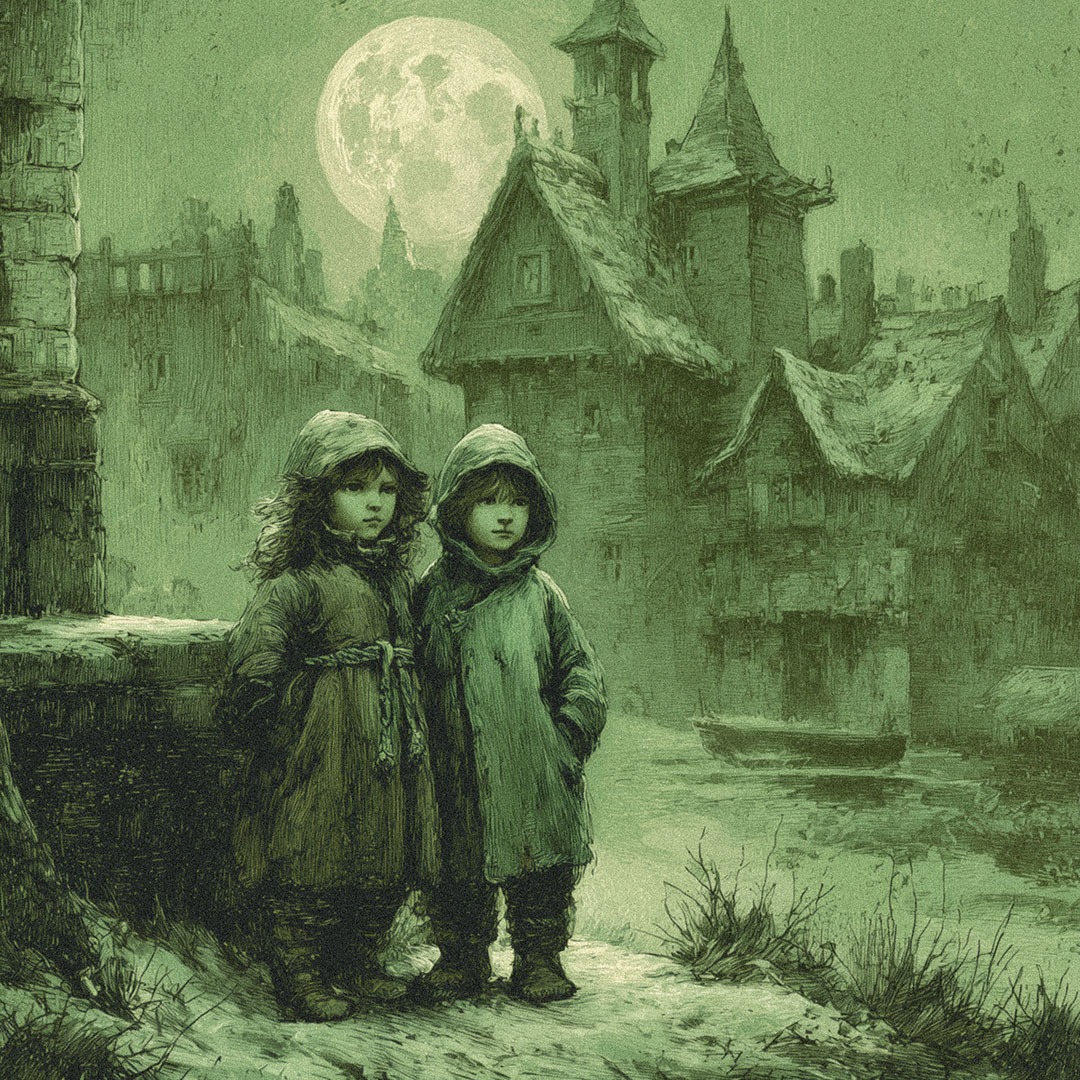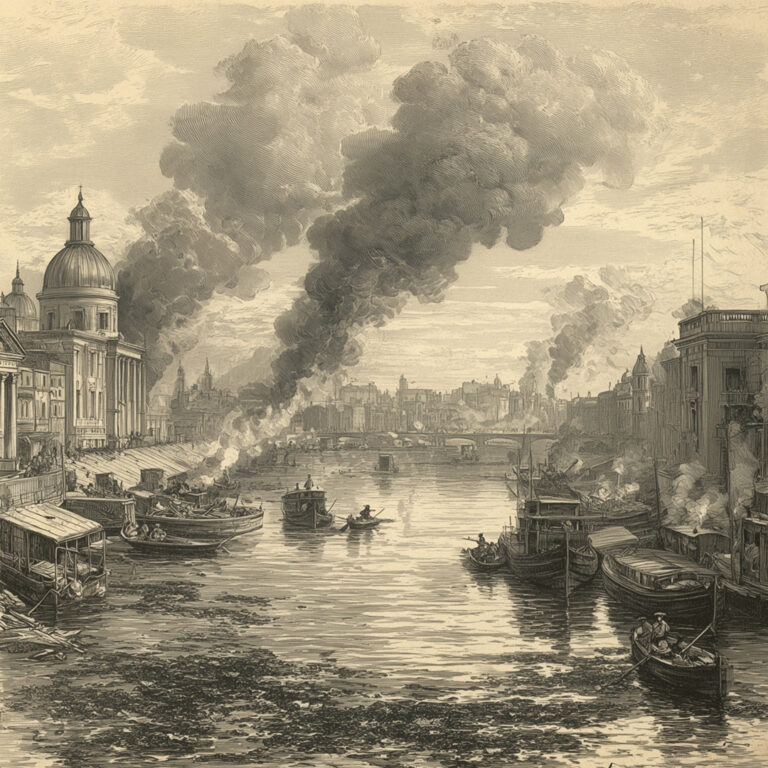The Green Children of Woolpit: A Medieval Mystery
Picture a Suffolk afternoon at harvest time. The fields around Woolpit lean and glitter in the sun, the air humming with insects, the rhythm of scythes steady as breath. Out beyond the hedgerow, something stirs. Two children step from the verge and into view, a boy and a girl, clothes unfamiliar, faces drawn from a different map. Their skin holds a strange green cast, as if the shade of leaves has settled into it. They speak, but the sounds belong to no tongue the villagers know. For a moment, the field stands still, and in that pause, the world feels larger than it did a heartbeat before.
The villagers lead the pair to shelter. The children look at the bread and meat offered to them and turn away in quiet refusal. Then someone brings beans, fresh and green. The children brighten at once. They pull the beans from their pods and eat, quick with relief, as if finding a known door in a foreign street. It is a small answer in a larger riddle, and it keeps them alive long enough for the story to take root.
The Chronicle and the Shadow
Two medieval writers recorded what happened in Woolpit: William of Newburgh and Ralph of Coggeshall. They wrote in different places and with different aims, the way any two witnesses describe the same light from different windows. Yet their accounts agree on the outline. Two children appeared in the fields. Their skin showed a greenish tint. They did not understand the language around them at first. They would eat only certain foods. The boy grew weak and died. The girl learned enough English to explain, as best she could, where she believed they had come from.
The chroniclers note that the girl spoke of a land under faint light, where day never fully arrived and a soft dusk lingered like mist. In that place, she said, bells sounded from across a river, and a bright region lay just beyond. She told of losing her way and following the sound until an opening in the ground delivered them into a field of blinding sunlight. The villagers thought of the wolf pits that gave Woolpit its name, deep traps once dug to catch predators. The landscape itself seemed to participate in the tale, as if the earth kept secret doors.
Language, Appetite, and Belonging
There are folktales of children found in the forest, feral and luminous with rumor. This story is not quite that. The Woolpit children did not speak with animals or vanish into trees. They learned words slowly, the way any child might when moved to a new place. They shifted their appetites to match what others ate. One made it through, and in time, she entered ordinary life and found work in a household. Marriage followed. All of this sounds like the narrow path from otherness into belonging, a path that leaves marks that can fade almost to nothing. Yet the green made it unforgettable. It turned a common story of strangers into a legend with edges that catch the light.
Green carries its own meanings. It is the shade of youth and growth, and also the tint of sickness. The eyes of the villagers did not have a modern vocabulary for anemia or malnutrition. They had color and rumor and the felt truth of what stood before them. The girl’s skin changed as her diet changed. That detail lives in some retellings, the way color can return to a leaf.
Theories at the Threshold
Centuries have not settled the question of what happened in Woolpit. Theories multiply because the story invites them. Some scholars point to dietary deficiencies such as chlorosis, which can tint the skin and leave a person weak. Others trace the movement of people in that era and propose that the children were refugees from nearby conflict, perhaps Flemish, their language unknown to the villagers, their clothes unfamiliar, their lives thrown into confusion by fear and flight. In that case, the twilight land becomes a metaphor seen through a young mind remembering dark forests and long nights, or perhaps the dimness of illness.
There are more romantic proposals. A subterranean world, a door between realms, a crossing from faerie to field. Listen to the way the girl describes the place of her birth in some versions. The day never really arrived. A bright country lay across a river. Bells could be heard. It reads like a pilgrim dream. It could be a child’s geography of heaven, or an echo of distant churches across marsh and fen. Stories travel inside people and come out transformed. A child might mix memory with longing and find something that feels true, even if it’s not literal. That is how folklore grows. It is also how a mind makes sense of what it survived.
Why the Story Holds
Many medieval wonders have slipped from the common shelf to the attic of specialists. The green children remain visible. Part of the hold is visual. Two children emerge from the hedgerow with skin the color of new leaves. That image lands and stays. Part of the hold is ethical. The villagers’ initial response is not rejection. It is shelter and food. Part of the hold is an unresolved possibility. The story has just enough factual grain to invite serious attention, and just enough strangeness to resist closure.
It also speaks to a recurring human experience. A stranger arrives in a place where they do not share the language. That stranger learns the words and the customs. Some people treat them with kindness. Some look away. Over time, they join the fabric of the town and leave behind descendants who carry only a softened echo of how the family first arrived. The Woolpit tale gives that pattern a color and a glow. It paints a history of migration and welcome in a language more memorable than census records.
Place as Character
Stand near Woolpit on a late afternoon and the land itself explains part of the charm. Suffolk offers big sky and low horizons. Sound carries. Bells can travel farther than you expect, especially across open fields and water. The village name remembers the wolf pits that once punctured the earth. It is not difficult to imagine a place where ground and story collaborate, where a child stepping from a shaded copse into full sun feels briefly caught between worlds, where a bell a mile away seems both here and elsewhere. The mind makes myth from these ingredients without much help.
Sources and Gaps
William of Newburgh and Ralph of Coggeshall wrote for their times, with the biases of their monasteries and the limits of what they heard. Their texts keep the tale in circulation but do not settle it. They preserve facts that can be weighed and narrative touches that belong to literature. Folklorists read them one way, while historians read them another. Both are correct within their lanes. The truth likely has several layers. A pair of children arrived under conditions we cannot fully reconstruct. Illness colored their appearance. Hunger shaped their choices. The village took them in. One child died. The other learned to live. The green faded, yet the memory of it did not.
What we do with that memory says as much about us as it does about them. Some readers want a tidy solution, a diagnosis to pin the case to the wall. Others prefer the shimmering remainder, the sense that the world is larger than our categories. There is value in both impulses. Certainty gives comfort. Wonder gives meaning.
The Afterglow
Every so often, a story like this steps out of its century and looks directly at us. It asks what we notice when someone different enters our field of view. It asks whether we feed them, whether we listen long enough for language to form between us. It asks whether we can hold two ideas at once. That the world is explainable to a point. That beyond that poin,t there is room for mystery that does not collapse under analysis.
The green children of Woolpit do not need to be from underground to matter. They are already from the far side of familiarity. They stand at the edge of a golden field, hungry and unsure, and they carry a rumor of a place where the light never quite rises. The villagers who find them do not solve the riddle. They solve the immediate problem. Beans first, words later. The rest follows. It is a simple order of operations that continues to feel right.
We keep returning to Woolpit because the scene is both specific and symbolic. A real village. A recorded event. Human responses we recognize. A color that does not make sense and yet refuses to leave the story. Between those elements, a bridge appears. On one side is a field under the English sun. On the other side is the part of human experience that cannot be entirely measured. The children walk across it, and for a momen,t we are reminded that the path between the two is open more often than we think.

